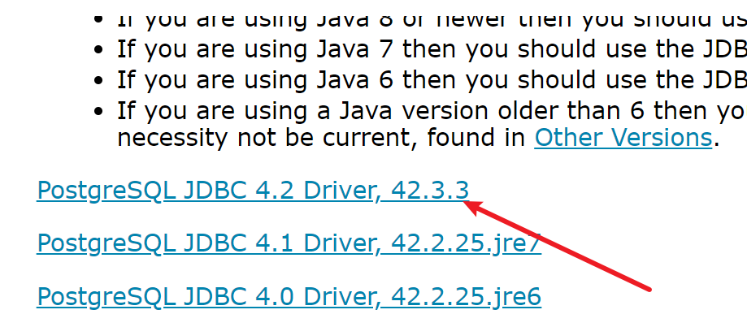Java连接PostgreSql数据库及基本使用方法是什么
短信预约 -IT技能 免费直播动态提醒
这篇文章主要介绍“Java连接PostgreSql数据库及基本使用方法是什么”的相关知识,小编通过实际案例向大家展示操作过程,操作方法简单快捷,实用性强,希望这篇“Java连接PostgreSql数据库及基本使用方法是什么”文章能帮助大家解决问题。
一)准备工作
1.下载链接需要的jar包
选择最新版本即可。

2.下载之后添加到模块里

3.创建一个工具类Util
书写空参构造,用于对数据库的全部操作。
二)连接
所需内容:数据库名,端口号,数据库地址,数据库用户名,密码
public static Connection Connect(){ Connection c = null; try { Class.forName("org.postgresql.Driver"); c = DriverManager .getConnection("jdbc:postgresql://服务器地址,本机写127.0.0.1:服务器端口号,默认5432/链接的数据库名", "数据库用户名", "数据库密码"); } catch (Exception e) { e.printStackTrace(); System.err.println(e.getClass().getName()+": "+e.getMessage()); System.exit(0); } System.out.println("Opened database successfully"); return c; //记得返回一下这个对象,后面一直在用 }三)查询
普通版本查询:数据库有三个字段,时间time、地点location、温度temperature
public static void select() { //与数据库建立链接 Connection c = Util.Connect(); Statement stmt = null; try { stmt = c.createStatement(); String sql = "SELECT* FROM tmps;"; ResultSet rs = stmt.executeQuery(sql); while (rs.next()) { Date date = rs.getDate(1); String location = rs.getString("location"); float temperature = rs.getFloat("temperature"); System.out.println("date" + date); System.out.println("location:" + location); System.out.println("temperature:" + temperature); } //关流操作 rs.close(); stmt.close(); c.close(); } catch (SQLException throwables) { throwables.printStackTrace(); } }下图中这种方法属于进阶方法,只需要输入sql语句即可将任意表中的数据都按照map集合的方式返回
public static List<HashMap<String,Object>> Select(String sql){ //1、与数据库建立链接 Connection c = Util.Connect(); //2、创建操作对象 Statement stmt = null; //3、创建返回最终查询的数据集合 List<HashMap<String ,Object>> list=new ArrayList<>(); try { //2.1、初始化操作对象 stmt = c.createStatement(); //4、执行需要执行的sql语句 ResultSet rs = stmt.executeQuery(sql); //3.1开始封装返回的对象 ResultSetMetaData metaData = rs.getMetaData();//获取全部列名 int columnCount = metaData.getColumnCount();//列的数量 //5、读取数据 while (rs.next()) { HashMap<String,Object> map=new HashMap<>(); for (int i = 1; i <= columnCount; i++) { //getColumnName获取列名 String name = metaData.getColumnName(i); //获取对应的元素 Object object = rs.getObject(i); map.put(name,object); } list.add(map); } //6、关流操作 rs.close(); stmt.close(); c.close(); } catch (SQLException throwable) { throwable.printStackTrace(); } return list; }四)添加
返回值是bool类型,表示是否添加成功。
***需要比查询多添加一句***
connect.setAutoCommit(false); public static Boolean Insert(String sql){ //1、与数据库建立链接 Connection connect = Util.Connect(); //2、创建操作对象 Statement stmt = null; int count = 0; try { //2.1、初始化创建对象 stmt=connect.createStatement(); //3、添加特殊语句。 connect.setAutoCommit(false);//之前不用 //4、执行添加操作 count = stmt.executeUpdate(sql); //5、关流 stmt.close(); connect.commit(); connect.close(); } catch (SQLException throwables) { throwables.printStackTrace(); } return count!=0; }五)删除数据
public void Delete(String sql) { //1、链接数据库 Connection c = this.Connect(); Statement stmt = null; try { c.setAutoCommit(false); stmt = c.createStatement(); stmt.executeUpdate(sql); c.commit(); c.close() stmt.close(); } catch (SQLException throwable) { throwable.printStackTrace(); } }六)封装之后的代码总和
封装类
package postSQL.Util; import java.sql.*;import java.util.ArrayList;import java.util.HashMap;import java.util.List; public class Util { private final Connection connect; private final String userName; private final String passWord; private final String ipAddress; private final String databaseName; private final String port; //构造方法 public Util(String userName, String passWord, String ipAddress, String databaseName, String port) { this.userName = userName; this.passWord = passWord; this.ipAddress = ipAddress; this.databaseName = databaseName; this.port = port; this.connect = this.Connect(); } //建立链接 private Connection Connect() { Connection c = null; try { Class.forName("org.postgresql.Driver"); c = DriverManager .getConnection("jdbc:postgresql://" + this.ipAddress + ":" + this.port + "/" + this.databaseName, this.userName, this.passWord); } catch (Exception e) { e.printStackTrace(); System.err.println(e.getClass().getName() + ": " + e.getMessage()); System.exit(0); } return c; } //关流操作 public void close() { Connection c = this.connect; try { c.close(); } catch (SQLException throwables) { throwables.printStackTrace(); } } //查询 public List<HashMap<String, Object>> Select(String sql) { //1、与数据库建立链接 Connection c = this.connect; //2、创建操作对象 Statement stmt = null; //3、创建返回最终查询的数据集合 List<HashMap<String, Object>> list = new ArrayList<>(); try { //2.1、初始化操作对象 stmt = c.createStatement(); //4、执行需要执行的sql语句 ResultSet rs = stmt.executeQuery(sql); //3.1开始封装返回的对象 ResultSetMetaData metaData = rs.getMetaData();//获取全部列名 int columnCount = metaData.getColumnCount();//列的数量 //5、读取数据 while (rs.next()) { HashMap<String, Object> map = new HashMap<>(); for (int i = 1; i <= columnCount; i++) { //getColumnName获取列名 String name = metaData.getColumnName(i); //获取对应的元素 Object object = rs.getObject(i); map.put(name, object); } list.add(map); } //6、关流操作 rs.close(); stmt.close(); //c.close(); } catch (SQLException throwable) { throwable.printStackTrace(); } return list; } //插入操作 public Boolean Insert(String sql) { //1、与数据库建立链接 Connection connect = this.connect; //2、创建操作对象 Statement stmt = null; int count = 0; try { //2.1、初始化创建对象 stmt = connect.createStatement(); //3、添加特殊语句。 connect.setAutoCommit(false);//之前不用 //4、执行添加操作 count = stmt.executeUpdate(sql); //5、关流 stmt.close(); connect.commit(); //connect.close(); } catch (SQLException throwables) { throwables.printStackTrace(); } return count != 0; } //删除 public void Delete(String sql) { //1、链接数据库 Connection c = this.Connect(); Statement stmt = null; try { c.setAutoCommit(false); stmt = c.createStatement(); stmt.executeUpdate(sql); c.commit(); stmt.close(); } catch (SQLException throwable) { throwable.printStackTrace(); } }}使用测试类
public static void main(String[] args) { //构造方法 Util util=new Util("用户名","密码", "ip地址","数据库名","端口号"); //插入语法 Boolean insert = util.Insert("insert into tmps (time,location,temperature)" + " values('2022-1-1 16:00:00','场景八',112.3);"); //插入 //删除 util.Delete("delete from tmps t where t.location='场景七' "); //查询 List<HashMap<String, Object>> select = util.Select("select * from tmps"); //关流 util.close(); System.out.println(select); }关于“Java连接PostgreSql数据库及基本使用方法是什么”的内容就介绍到这里了,感谢大家的阅读。如果想了解更多行业相关的知识,可以关注编程网行业资讯频道,小编每天都会为大家更新不同的知识点。
免责声明:
① 本站未注明“稿件来源”的信息均来自网络整理。其文字、图片和音视频稿件的所属权归原作者所有。本站收集整理出于非商业性的教育和科研之目的,并不意味着本站赞同其观点或证实其内容的真实性。仅作为临时的测试数据,供内部测试之用。本站并未授权任何人以任何方式主动获取本站任何信息。
② 本站未注明“稿件来源”的临时测试数据将在测试完成后最终做删除处理。有问题或投稿请发送至: 邮箱/279061341@qq.com QQ/279061341





















